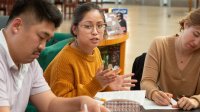Fostering an Effective Professional Learning Community at Your School
A look at how school leaders can promote the establishment and success of a professional learning community for teachers.
Your content has been saved!
Go to My Saved Content.While teachers and school leaders have shown great resilience over the last two years, schools that have a strong professional learning community (PLC) presence have seen amazing results despite the pandemic, with learners, families, and teachers enjoying the learning process and working together effectively.
A professional learning community, according to Louise Stoll, a professor at University College London’s Institute of Education, is “an inclusive and mutually supportive group of people with a collaborative, reflective and growth-oriented approach towards investigating and learning more about their practice in order to improve pupils’ learning.”
Here’s how to ensure that PLCs are an integral part of the school.
Main Features of a Successful PLC
Shared values and vision: Teachers and school leaders share the main values concerning raising children and developing their learning skills. They also have a common mindset and attitude when it comes to big issues like children’s rights, the environment, and the role of the individual in the community.
For example, teachers and school leaders reach a consensus about the teaching and learning approach that the school should pursue. This doesn’t mean there won’t be different positions and points of view, but once they’ve chosen an approach, the whole community works together.
Collective responsibility: Successful professional learning communities understand that teachers and school leaders share the same responsibility regarding the learners’ progress and achievements. For instance, the PLC might notice that learners of all ages need to spend more time with nature. To make learning more meaningful for students, teachers and school leaders might agree to develop the curriculum in a new teaching context—for example, the beach or a forest. The teachers’ commitment to adapt the curriculum to the new teaching context determines the success of this new approach.
At the same time, school leaders can provide the necessary guidance and support to teachers and find a way to make it possible for students to learn outdoors regularly every week, possibly inviting teacher assistants to help, increasing the child-adult ratio.
Reflective professional inquiry: PLCs need time to reflect on the learners’ development in all areas—academic, emotional, social, physical—and also to foster areas of inquiry that will provide relevant information. For example, PLCs might notice that learners are showing signs of being tired after daily online lessons. So, they might develop an inquiry project about how to protect learners from burnout, looking into different techniques and strategies for making learning more effective without relying so much on online synchronous lessons.
This research could generate inspiring hours of active exchange among PLC members, with deep reflection and analysis of data that hopefully would result in new lesson plans and a more active and motivated group of learners.
Collaboration: PLCs offer a support net that allows teachers to take risks and explore different paths for developing their teaching and learning skills and using innovative approaches and techniques to make learning more effective. Peer observation sessions are a good example of collaboration. One teacher invites another to observe their lesson. They both meet beforehand to discuss what to focus on, the concerns of the person being observed, and the type of feedback they’re looking for.
After the observation session, both teachers meet, and the observer provides constructive feedback. For the peer observation session to be successful, both teachers need to trust and respect each other professionally and feel confident enough to express their opinions, feelings, and thoughts with each other. In this way, PLCs can promote both group and individual learning and growth.
How School Leaders Can Promote Acceptance of the PLC
Start slowly: Take baby steps. Two or three times during the year—for example, at the beginning of the school year, before the winter break, and near the end of the year—guide the PLC to reflect on each member’s strengths and become aware of what they need to improve. If possible, choose one or two items, not more, to work on in the following months. Then, create an action plan.
Increasingly integrate formal and informal collaboration: Invite teachers who are still reluctant to become an active member of the PLC. Teachers are all facing different personal situations and might need some time to decide to participate in a PLC. So, accept different levels of commitment and participation. Allow people to collaborate in their own way.
Persevere: PLCs take time to grow, and they have their ups and downs, as all social and professional groups do.
Take advantage of technology: School leaders have a great tool that can facilitate interaction and participation. During the pandemic, teachers developed the skill of managing online meetings and might prefer having remote meetings to staying at school after hours. Every now and then, allow the PLC to work remotely.
Finally, learn to let go: Once the PLC is fully integrated into teachers’ work, school leaders can ask different teachers to lead at times. Promote that, allow other leaders to emerge, and foster the autonomy of the PLC.
